|
Steering
Clear: Auto Outsider Gets Fiat Going By Flouting Industry
Traditions - Marchionne Keeps All Plants Open, Cuts
Discounting, Sells Technology to Rivals - Taking an Axe to
Management
By Gabriel Kahn and Stephen Power - The Wall Street
Journal / Thursday October 26, 2006
At the headquarters of Fiat SpA here, an auto
industry outsider is engineering a turnaround of a company
considered the biggest mess in the industry two years ago.
He's doing it with an in-your-face taunt: The leaders of
many of the world's largest auto firms have lost their way,
says Chief Executive Sergio Marchionne. If you're going to
fix a broken car company, call in an amateur.
When Fiat hired him in June 2004, the company acknowledged
it was just months away from running out of cash. It had
lost about US$2.4 billion the year before. A four-year-old
alliance with General Motors Corp. was on the rocks.
Mr. Marchionne had never worked in the auto industry. He was
running a century-old Swiss company that inspected and
certified goods moving in trade. He was Fiat's fifth CEO in
three years. Labor leaders and analysts figured there would
soon be a sixth.
Today, Fiat is on a tear. Sales were up 19% in the first
nine months of this year. Its auto business is profitable.
The stock has doubled since a year ago.
"All of this sounds like a miracle," Mr. Marchionne said at
an industry conference in June. "But it is not. And it is
explainable."
The newcomer mocked the auto-industry dogma that factory
closings were the answer to the industry's problems.
Instead, he took a knife to the bureaucracy.
He bucked the standard industry practice of hoarding one's
best technology. Mr. Marchionne pushed to sell as many of
Fiat's engines and other parts as he could, even to
competitors.
He boasted that Fiat at first would be selling fewer cars,
not more, as he stamped out steep discounts. They are a
common practice in the industry, particularly in the U.S.,
where GM and Ford Motor Co. have often pushed cheap
financing to keep sales up. Mr. Marchionne figured that
though such promotions buoyed Fiat's market share, they
widened its losses and cheapened the brand.
He also insisted that designers and engineers radically
speed the process of bringing out a new model, skipping the
step of building a working prototype. The result was to
shave six months off the standard design-to-market time of
24 months or more.
Finally, instead of seeking a rescue through a broad
alliance - as Renault SA and Nissan Motor Co. have, and as
GM considered doing - Fiat has pursued smaller, targeted
joint ventures.
Fiat's turnaround isn't finished, and analysts caution
against overstating it. Much of its sales surge reflects the
success of just one model, a small, sporty sedan called the
Grande Punto. Many analysts doubt Fiat can ever fully
overcome the hurdle of being a builder of small cars, on
which margins are thin, in a high-cost place like Europe.
"We believe that Fiat is an overvalued turnaround story in
which the market is likely to lose faith," wrote one
analyst, Stephen Cheetham of Sanford C. Bernstein & Co.,
this month.
Yet it's clear Mr. Marchionne's unconventional approach is
producing results so far. He maintains that his overhaul has
revolutionized the culture in a way that will keep the
company competitive in the long term, even against lean
Asian rivals. Besides its main unit, Fiat Auto, the company
makes Iveco trucks, Case New Holland farm equipment and two
expensive car brands that aren't part of Fiat Auto, Ferrari
and Maserati. Although Fiat's flagship brand left the
American market years ago, Ferraris and Maseratis continue
to be sold in the US.
The auto industry normally cultivates its executive talent
from within. But the bleak conditions in some corners of the
industry have lent appeal to the idea of an outsider who can
shake things up with new ideas. Ford has also gone outside
for a CEO, hiring Boeing Co. executive Alan Mulally.
When Mr. Marchionne arrived at Fiat, many expected him to
use its financial crisis as a lever to force unions to
accept a factory shutdown. Fiat's European factories were
running at just 60% of capacity, analysts estimate, far
below the 80% to 90% thought needed for profitable
operation. Other companies, such as GM and Ford, are
attacking their woes through extensive plant closings and
worker buyouts.
But Mr. Marchionne pledged not to shut any of Fiat's Italian
factories, even a chronically inefficient one in Sicily that
was slated for closure under prior management. One special
situation made this easier. An Italian law permits an
industrial company that's financially on the ropes to send
workers home temporarily and pay only a portion of their
salary. Still, Mr. Marchionne's decision not to close any
factories astonished industry analysts and even fellow Fiat
executives.
Labour is only 6% to 7% of the cost of making a car, Mr.
Marchionne told a group of industry insiders in June.
"Therefore," he said, "the real reason for large operating
losses at Fiat Auto must be found elsewhere." He figured
that the industry's constant focus cutting factory payrolls
was an excuse to avoid tackling tougher problems.
He looked to the management ranks. Fiat's controlling
shareholders are the Agnelli family, known for style and
formality. This sensibility was mirrored, to some degree, in
the Fiat hierarchy. Executives who worked in the same hall
would schedule appointments to speak to each other through
their secretaries.
That wasn't Mr. Marchionne's style. An intense man who
rarely wears a tie, he spends much of the day when in his
Turin office in nonstop meetings, smoking a steady stream of
Kents, often with Bach playing in the background. At his
first major outing as CEO, in July 2004, Mr. Marchionne was
blunt about Fiat's management. It was "inward looking," he
told analysts and journalists, and its approach to business
"needs to change and change drastically."
He said Fiat, which was selling 30% fewer cars than a few
years earlier, no longer needed the same number of managers.
Of more than 700 at the car unit, 30% were sent packing, for
an annual saving of about US$160 million. At the corporate
level, he dismantled a 300-person management layer that
monitored the company's truck, tractor and car units. "It showed we've taken responsibility from the top for the
problems," says the head of human resources, Francesco Garello.
|
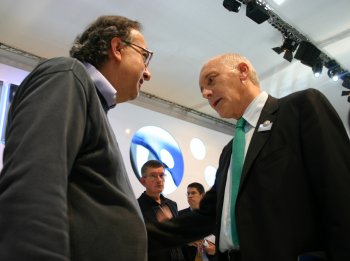 |
|
Mr. Marchionne (above left, at the Paris Motor Show
last month with Ferrari's Antonio Ghini) concedes that Fiat isn't out of the
woods. But its progress so far has led to a surge of
self-confidence and a change in how the company is
regarded. |
|
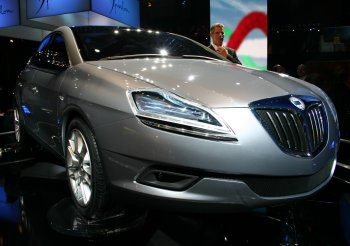 |
|
Sergio Marchionne was baffled by what he says is the
industry's tendency to be "capital happy" -
reported the Wall Street Journal - rolling
the dice on costly new models without first doing
lots of market research. His new thinking is now
being applied to the Lancia Delta HPE Concept (above, at
last month's Paris Motor Show). |
|
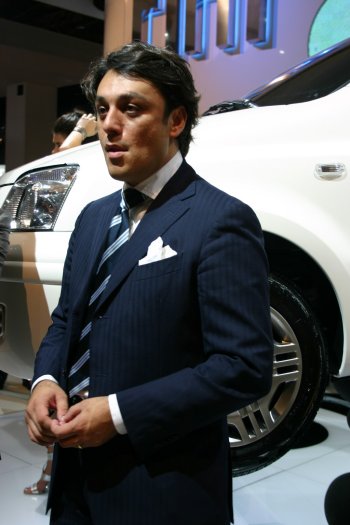 |
|
While laying managers off, Mr. Marchionne promoted others.
Soon after arriving, he knocked on the door of Luca De Meo,
director of Fiat's Lancia car brand. "He walked into my
office and said, 'Who are you?'" says Mr. De Meo. |
|
|
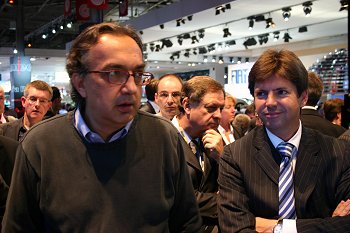 |
|
The leaders of many of the world's largest auto
firms have lost their way, says Chief Executive
Sergio Marchionne (above: at the Paris Motor Show
last month, with Lancia CEO Olivier Françoise). If you're going to fix a broken
car company, call in an amateur. |
|
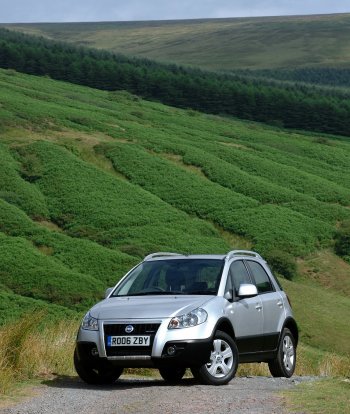 |
|
Sergio Marchionne gave the manager who had overseen the
GM relationship a new mission: Find some new
alliances, but narrower ones that would plug Fiat's
weaknesses and leverage its strengths. He told the
executive, Alfredo Altavilla, to steer clear of
equity investments, for a simple reason: "We had no
money." |
|
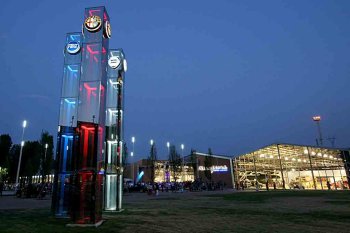 |
|
Luca De Meo espoused the unorthodox approach. He hired
consultants from Swedish retailer Ikea to give stodgy
dealerships an airy, consumer-friendly feel. |
|
|
"We haven't put the blame on the factory workers
but on the decision makers. That had an enormous cultural
impact."
While laying managers off, Mr. Marchionne promoted others.
Soon after arriving, he knocked on the door of Luca De Meo,
director of Fiat's Lancia car brand. "He walked into my
office and said, 'Who are you?'" says Mr. De Meo. The two
talked for 90 minutes about the company's problems.
Weeks later, Mr. De Meo was put in charge of the core Fiat
brand, even though the 39-year-old had been at Fiat less
than three years. "He hadn't been with the organization long
enough to pick up any bad habits," Mr. Marchionne says.
Mr. De Meo espoused the unorthodox approach. He hired
consultants from Swedish retailer Ikea to give stodgy
dealerships an airy, consumer-friendly feel.
But Fiat faced a roadblock. An alliance it had made with GM
in 2000, as a way to catapult itself into the orbit of the
world's largest car maker, had turned acrimonious, with both
sides threatening lawsuits.
In the deal, GM had taken a 20% equity stake in Fiat Auto
and agreed that if things went badly, Fiat Auto could sell
the rest of itself to GM. At the time, with Fiat healthy, no
one expected this clause to matter much. But by 2004, with
Fiat on the ropes, GM worried that the Italian company might
exercise the clause and force GM to absorb some US$8.8 million
of Fiat debt. Mr. Marchionne, at a meeting with GM CEO
Richard Wagoner in January 2005, insisted that GM pay to get
out of what was in effect a put option. Mr. Wagoner agreed
to pay US$2 billion.
The cash gave Fiat some breathing room, but the end of the
alliance left it a pint-size player in the global auto game.
Mr. Marchionne gave the manager who had overseen the GM
relationship a new mission: Find some new alliances, but
narrower ones that would plug Fiat's weaknesses and leverage
its strengths. He told the executive, Alfredo Altavilla, to
steer clear of equity investments, for a simple reason: "We
had no money."
They also didn't have much respect. Mr. Altavilla recalls
that as he talked with industry executives, they kept
asking, "Will you still be around in six months? Will you be
able to supply spare parts in three years?"
But Fiat had some strong technology to offer, including a
highly efficient 1.3-liter diesel engine. Mr. Altavilla
signed a deal to produce small cars jointly with Ford, at a
Fiat plant in Poland. Ford would get a small car powered by
Fiat's engine and built on a Fiat platform. Fiat, in effect,
would get to sell the use of some of its technology and
facilities, collecting more revenue from its plants.
Most car makers hoard their best technology rather than let
rivals have access to it. Mr. Marchionne thought that was
"crazy," says Mr. Altavilla, figuring that "your competitor
will just go to somebody else to buy" something equivalent.
Mr. Altavilla has signed nine deals, helping Fiat both to
widen its model lineup and enter new markets. One
arrangement is with the car division of Russian steelmaker
OAO Severstal, which will sell Fiats through its dealership
network in Russia. Another is with Turkish auto maker Tofas
and France's PSA Peugeot Citroen SA to make a small cargo
vehicle. By next year, the fast-growing Indian car market
will include two brands equipped with Fiat's small diesel
engine: cars from Fiat and Tata Motors Ltd. in Mumbai.
Mr. Marchionne was baffled by what he says is the industry's
tendency to be "capital happy" - rolling the dice on costly
new models without first doing lots of market research. He
says this habit was especially bad at Fiat: "We only
listened to the customers after the cars were launched."
The result was sales projections that could be badly off the
mark. Five years ago, Fiat launched its Stilo model,
expecting it to sell as many as 360,000 a year. It peaked at
160,000 in 2002. The result was huge excess production
capacity and parking lots full of unsold cars. Moving them
required steep discounts that cannibalized sales of other
models.
Mr. Marchionne told product-development people to sharply
understate sales projections. Instead of designing a model
that could make money only if it sold 300,000 a year, they
had to design it to be profitable if it sold half that many.
It was up to the designers and engineers to figure out a
way.
At the same time, he required more market-testing, even of
car interiors. On the Grande Punto, he approved a bright
orange interior even though he hated it, because consumer
focus groups liked it.
When Mr. Marchionne arrived, Fiat Auto's engineering and
design department had five independent units and two
international divisions, each developing products on its
own. There was little communication or synergy, and morale
was abysmal, says Harald Wester, a new product-development
chief the CEO hired.
Fiat was preparing to replace the Stilo with a model called
the Bravo, of a size similar to compacts in the U.S. Mr.
Wester says the Bravo was "mediocre," had no "wow factor."
He ordered it redesigned, a move that engineers said would
mean a six-month delay in its launch. No delays, Mr. Wester
retorted. In fact, he demanded, the Bravo must be launched
six months earlier than planned.
To do so meant adopting an entirely new engineering process
that skipped the step of building prototypes. "A healthy
company would never have thought about doing it like this,"
says Mr. Wester, but "extraordinary situations lead to
extraordinary solutions." He says Mr. Marchionne approved
the plan, except for one change: "He asked us to deliver it
one month earlier." The Bravo is set to go into production
next month.
Labor unions at Fiat have a history of strikes and even
violent confrontation with management, but Mr. Marchionne's
openness appears to have softened attitudes a bit. Recently,
he stood before hundreds of union officials to answer their
questions. "We had never seen anything like that before at
Fiat," says Giorgio Airaudo, secretary of the Turin section
of a left-wing union, FIOM-CGIL.
The company and unions operated for years with no contract
after the last one expired. For 10 years, unions had been
pushing for a new one. They were astounded when Mr.
Marchionne proposed a new one, with a clear formula for
bonuses, which would be based on quality, productivity and
financial results. It was signed in June.
Mr. Marchionne concedes that Fiat isn't out of the woods.
But its progress so far has led to a surge of
self-confidence and a change in how the company is regarded.
"We were considered the biggest losers in Europe," says Mr.
Wester. Now, "my people don't get teased at the bar anymore
for being from Fiat."
Report courtesy of
The Wall Street Journal
|
|
|
|